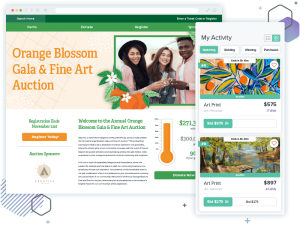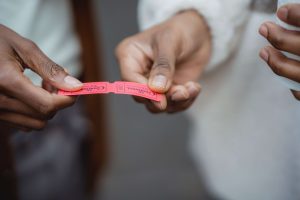If you’ve been following the Diary of a Peer-to-Peer Fundraiser series, you know that I just had the pleasure of participating in my very first peer-to-peer fundraiser (if you’re not familiar with this fundraising style, learn all about it right over here!). The whole process of participating in the Lakeland Derby was a blast for a number of reasons.
First and foremost, it was a fantastic opportunity to support Lakeland Volunteers in Medicine, a nonprofit that’s doing great work in Qgiv’s hometown. They’re also a Qgiv client! We’ve seen them do some pretty amazing things with our tools — check out some of what they’ve accomplished!
Additionally, actually getting to raise money myself was fun. I write extensively about different fundraising methods, and it was really nice to actually use the strategies I’ve researched and written about. It really drove home that raising money is hard! It’s nerve-wracking, even if you know all the industry best practices. It also reiterated that you can know every statistic and best practice out there and still need to experiment. And, honestly, it was fun to use Qgiv’s tools as a user, not as a Qgiv employee.
One of the best parts of the whole experience, though, is seeing firsthand how a nonprofit runs a successful peer-to-peer event year after year. They’ve honed and refined the processes around the Lakeland Derby over several years, and I was lucky enough to identify some strategies that could be useful to anyone who wants to run their own event.
Several of the most important strategies surround closing out the event itself. Once the event is over, there’s still work to be done! Here are some steps the LVIM staff took to bring the event to a close.
- They sent us an immediate thank-you email
- They let us know about an upcoming event
- They sent us donor information
- Previously in the Diary of a Peer-to-Peer Fundraiser
They sent us an immediate thank-you email
Everyone who participated got a thank-you email from LVIM staff. It was simple and straightforward: they thanked us for participating, told our group how much money we had raised, and reiterated that we’d helped provide hundreds of thousands of dollars of health care for people in our community.
It was a short email, but it made a big impact! What stood out most is that it was a simple thank you. They didn’t ask us to donate. They didn’t ask us to share anything with our social networks. It was a real, honest, sincere thank-you. It was so refreshing! After spending a month raising money, I felt seen and appreciated.
What you can do
Thank your participants! And please, just thank them. Thank-yous lose their power when you use them as an opening to ask for something else. Your participants have spent a ton of time, energy, and social capital raising money for you. The few days after your event is the time to thank them and tell them how much of a difference they’ve made. Additional asks can come later.
Looking for great thank-you letter ideas? This article breaks down a great donor thank-you letter; use it as a guide to write a thank-you note that will blow away your participants! It’s a great format for donors, too.
They let us know about an upcoming event
As part of our thank-you, we received an invitation to an upcoming event. And this is the important part: it’s not a fundraising event! Just before the Lakeland Derby, LVIM’s new location opened. The invitation is to a ribbon-cutting at their new facility. Each of us was invited to attend!
Now, I can’t speak for all of my fellow participants, but I can say that the ribbon-cutting means a lot to me after I spent a month raising money for LVIM and raising awareness about their presence in our community. Now that I’ve invested my time and energy in their success, their new facility is extra-special to me! I know that a lot of people are invited to this ribbon-cutting. But the fact that I received an invitation directly from LVIM in an email that thanked me for supporting them made me feel like I really helped accomplish something.
What you can do
Find an opportunity to engage with your participants! But — this is important — do not engage them immediately with another fundraising opportunity. Instead, invite them to something that either shows them the impact they’ve made or an event that engages them more deeply with your mission.
Do you have an upcoming donor appreciation event? That’s the perfect way to continue building a relationship with your participants! You could also explore opportunities like a wrap-up party for your event, a facility tour, or an invitation to a community event. The goal here isn’t to get more money from participants. The goal is to build an even better relationship with them!
They sent us donor information
This is something I hope every nonprofit does after a peer-to-peer fundraiser! A week or so after the event, the event coordinator for the Lakeland Derby sent each participant a spreadsheet containing the donor information for each person who gave to their respective team. That means that my husband and I (my husband was my teammate, which was fun) each got a copy of the names and addresses of each person who gave to us.
The event coordinator encouraged us to reach out to our supporters to thank them for their gift, which I think is really important. Each donor gets a receipt from the organization itself, of course, but a personal thank-you note from us to our donors is extra-special! The cool thing about peer-to-peer fundraising is that it’s a great way to reach donors you couldn’t reach on your own. But a drawback is that, often, a donor is giving to support your fundraising participants more than they’re supporting you. Asking your participants to write personal thank-you notes to their supporters is a valuable way to help reach those donors and make them feel special.
What you can do
After the event has concluded, give your participants their donors’ information. Ask them to send follow-ups to their individual supporters, and give them some useful information to include in those communications. When your participants are thanking their friends, make sure they can share specifics about their donors’ impact. Examples of specifics you can give them include how much money they raised overall, how donations make a difference, or details about the programs they helped fund.
If you give your participants the right information and good guidance, their thank-you notes can help you establish a good relationship with their supporters. That sets you up to keep those new donors engaged long after the event’s conclusion!
Previously in the Diary of a Peer-to-Peer Fundraiser
- Diary of a Peer-to-Peer Fundraiser: How to Transition Participants into Event Mode
- Diary of a Peer-to-Peer Fundraiser: How to Keep Participants Active
- Diary of a Peer-to-Peer Fundraiser: How to Empower Participants
- Diary of a Peer-to-Peer Fundraiser: How to Get Your Participants Inspired
- Diary of a Peer-to-Peer Fundraiser: How to Start Fundraising
Next up in the Diary of a Peer-to-Peer Fundraiser
You’ve put a lot of effort into recruiting and engaging your participants, and you’ve (ideally) encountered some brand-new donors who are interested in your nonprofit and your mission. In our final entry, we’ll explore steps you can take to keep your peer-to-peer participants (and their donors) engaged with your organization between events and, hopefully, for years to come.
Want to see how Qgiv’s peer-to-peer platform works?
You can do that! Contact us online to get more information or schedule a one-on-one tour of our tools. You’ll see exactly the same system our group of 20 participants used to raise $43,324.16! You can also check out these other really great peer-to-peer event examples from our clients.




